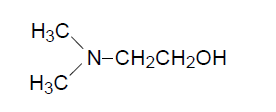Enhanced TDS
Identification & Functionality
- Blend
- No
- CAS Number
- 108-01-0
- Chemical Family
- Chemical Name
- Industrial Additives Functions
- Single Ingredient
- Yes
- Synonyms
- beta-Dimethylaminoethyl Alcohol, beta-Hydroxyethyldimethylamine, Deanol, Dimethyl(2-Hydroxyethyl)Amine, Dimethyl(Hydroxyethyl)Amine, Dimethylaminoethanol, Dimethylethanolamine, Dimethylmonoethanolamine, DMAE, DMEA, N,N-Dimethyl-2-Aminoethanol, N,N-Dimethylethanolamine, Norcholine, Propamine A
- Technologies
- Product Families
- Chemical Structure

Applications & Uses
- Industrial Additives End Use
- Markets
- Applications
- Application Information
It is used in flexible polyurethane slabstock foam as a co-catalyst to promote the gas blowing reaction. It is also useful in rigid and semiflexible foams. Because of the reactive hydroxyl group, JEFFCAT® DMEA catalyst becomes an integral part of the foam and contributes no amine odor to it. In addition, JEFFCAT® DMEA catalyst can be used as an acid scavenger in formulation involving polymeric isocyanates.
Properties
- Physical Form
Regulatory & Compliance
Safety & Health
- Toxocity and Safety
JEFFCAT® DMEA catalyst has a single oral dose LD50 of 2.03 ml/kg to young male albino rats and a single dermal dose LD50 by 24-hour skin contact of 3.53 ml/kg to male albino rabbits. On the basis of these results, the product is considered to be slightly toxic by ingestion in single doses and by single skin applications. Small quantities of the undiluted product are corrosive when placed in contact with rabbit skin or eyes. A group of male albino rats survived a 7-hour exposure at room temperature to air near saturation with vapor of the product.
Since JEFFCAT DMEA catalyst is corrosive to skin and eyes of the rabbit, precautions should be observed to prevent skin contact with the product and its introduction into the eyes. If eye contact occurs, the eye should be flushed immediately with water, and flushing should continue for at least 15 minutes. All cases of eye contact with this product should be seen promptly by a physician.
Breathing vapors of JEFFCAT® DMEA catalyst can cause irritation to the nose, throat, and lungs. Adequate exhaust ventilation should be provided to keep the workplace free of harmful vapor levels. A Threshold Limit Value has not been established for this material. In spill situations or other emergencies, a self-contained breathing apparatus or air-line masks are recommended. Canister-type gas masks can be used also, but their limitation must be thoroughly understood.
JEFFCAT® DMEA catalyst is classed as a combustible liquid (flash point 105°F). Ignition sources should be controlled where this material is handled, used, or stored. Fire-fighting procedures include the use of alcohol foam, carbon dioxide, or dry chemical. Water spray may be used to cool containers exposed to a fire.
Packaging & Availability
Storage & Handling
- Storage and Handling Information
In order to maintain the high degree of purity with which JEFFCAT® DMEA catalyst is manufactured and shipped, the following storage and handling considerations are recommended:
Dry Inert Gas Blanket
This product should be stored under a dry inert gas blanket, such as nitrogen, to minimize contamination resulting from contact with air and water.
Materials of Construction
Clean carbon steel is satisfactory as a material of construction for storage tanks and transfer systems provided adequate precautions are observed to guard against rust contamination. In those cases where additional precautions are needed to preserve low color, stainless steel or aluminum should be used. Copper or alloys containing copper should be avoided.
Storage Temperature
JEFFCAT® DMEA catalyst has an extremely low viscosity and freezing point (-58.6°C). It will not freeze or become viscous during normal handling even though subjected to very severe weather conditions.
Spills or Leaks
Eliminate all sources of ignition in case of JEFFCAT® DMEA catalyst spills or leaks. Spills should be removed by absorbing with dry absorbent materials or by washing with water
Other
- Appearance
- Clear liquid, substantially free of foreign matter
- Chemical Properties
Value Units Test Method / Conditions Amine Value 11.2 - Hydroxyl Value 630.0 mg KOH/g mg KOH/g pH 10.0 - - Physical Properties
Value Units Test Method / Conditions Boiling Point 135.0 °C °C Flash Point 41.0 °C °C Pensky-Martens Closed Cup (PMCC) Molecular Weight 89.14 g/mol g/mol Specific Gravity 0.9 - Viscosity 2.7 cSt cSt
